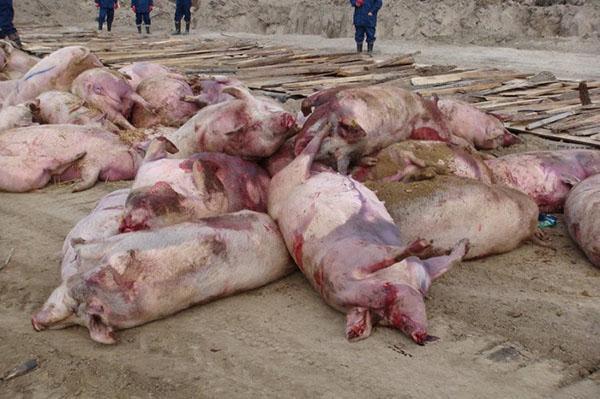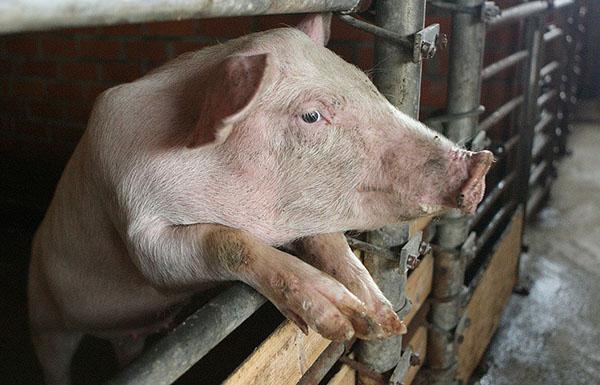African plague and other swine diseases
 In the past few years, even people far from animal husbandry have learned about the existence of one of the diseases of domestic animals. This is African swine fever, which has eclipsed other diseases.
In the past few years, even people far from animal husbandry have learned about the existence of one of the diseases of domestic animals. This is African swine fever, which has eclipsed other diseases.
Indeed, this infection, which is fatal to pets, still cannot be cured. Fortunately, it is not dangerous to humans. But there are a lot of diseases that threaten not only these animals, but also the person caring for them or eating contaminated meat and lard. Knowledge of the methods of treating pig diseases, their symptoms and methods of prevention will protect the owners of household farms and ordinary consumers from serious risks.
African swine fever

Not only is African swine fever susceptible to not only domestic but wild varieties, the disease affects all breeds and age categories and spreads in winter and summer. It sometimes takes less than a week from the moment the infection enters the pig's body to death. A virus released into the external environment under favorable conditions can remain viable for up to several years. Only:
- heat treatment at temperatures above 60 ° C;
- thorough treatment of all surfaces with preparations containing chlorine or formalin.
For people, the virus does not pose an immediate danger, but the personnel serving the farm, along with poultry and wild poultry, rats, mice and other animals that enter the field and pigsties, can spread a deadly infection. In this case, infection with African swine fever occurs:
- through direct contact with an infected or already sick animal;
- through unheated food or drinking water;
- when using the places of walking of the sick livestock or general inventory;
- through contact with carcasses of animals killed by the virus.
After infection, animals will die almost inevitably, and the surviving individuals become carriers of the infection for life.
Pig disease can be diagnosed based on the collected samples and analyzes. If the diagnosis is confirmed, quarantine is introduced on the farm and its district, treatment is not carried out, and the animals are destroyed.
Classical swine fever
In addition to the African variety, there is the classic swine fever, which, with its common name, differs in both the causative agent of the disease and the symptoms. This disease also has a viral nature and close sources of infection.
The main symptoms of swine fever include:
- temperature increase;
- apathy, loss of activity and appetite;
- redness, and then the discharge of purulent or bloody mucus;
- the appearance of red spots on the skin, as well as a rash.
For the treatment of classical swine fever, specialized sera are used, however, the advance use of vaccines that protect the adult livestock and young animals from a dangerous disease is much more effective.
Preventive measures that can seriously reduce the risk of spreading infection in both African and ordinary swine fever are associated with maintaining the hygienic condition of the pigsty and walking.
 Animals should be kept in clean, ventilated areas, receive approved feed and clean water, and not come into contact with strangers, rodents and birds. When suspicious symptoms appear in individual individuals, they are immediately isolated.
Animals should be kept in clean, ventilated areas, receive approved feed and clean water, and not come into contact with strangers, rodents and birds. When suspicious symptoms appear in individual individuals, they are immediately isolated.
Pig Pasteurellosis
Hemorrhagic septicemia or pig pasteurellosis is dangerous not only for domestic animals, but also for humans. Most often, the disease is recorded in farms where the livestock is kept in tight corrals.
 But infection of pigs with a bacterial nature with this disease provokes not only crowding. Sources of infection are:
But infection of pigs with a bacterial nature with this disease provokes not only crowding. Sources of infection are:
- sick individuals brought from other farms;
- exhaustion with poor nutrition;
- constantly high humidity in the pigsty;
- contaminated feed, water, bedding, tools and soil;
- insects and rodents.
Recovered and recovered individuals remain carriers of the infection, releasing the pathogen of pigs pasteurellosis into the external environment with droppings, saliva, urine and exhaled air.
Symptoms appear within two weeks of infection. The course of the disease varies from extremely acute to chronic, depending on which the manifestations of pig pasteurellosis and the duration of the disease may vary. Usually, animals die after 1–8 days, but with a chronic picture they live longer.
 Signs of the disease include:
Signs of the disease include:
- an increase in body temperature up to 41 ° C;
- difficulty breathing, signs of asphyxia;
- loss of appetite, depression;
- worsening cough with mucus and discharge from the nose;
- congestion in the chest, in the abdomen;
- swelling.
At the first symptoms of the disease, long-acting antibiotics and specialized serums are used to treat pigs.
In order to avoid the loss of a herd of pigs, it is necessary to vaccinate in advance using a highly targeted vaccine against pig pasteurellosis or complex preparations.
In addition, preventive measures should include:
- compliance with the conditions of quarantine, if animals are purchased from other farms;
- maintaining the sanitary condition of the premises, inventory and walking areas;
- fight against parasites and rodents in the territory of the courtyard.
Ascariasis of pigs
 Unlike African swine fever and other diseases, ascariasis is a helminthic invasion that is dangerous not only for animals, but also for humans. They suffer massively from the disease piglets from 3 months to six months. If symptoms of a disease of pigs are detected, treatment is prescribed immediately, otherwise the farm will not only lose part of the diseased livestock, but also reduce the productivity of the entire herd.
Unlike African swine fever and other diseases, ascariasis is a helminthic invasion that is dangerous not only for animals, but also for humans. They suffer massively from the disease piglets from 3 months to six months. If symptoms of a disease of pigs are detected, treatment is prescribed immediately, otherwise the farm will not only lose part of the diseased livestock, but also reduce the productivity of the entire herd.
Roundworms are large, parasitic worms in the small intestine that most often become infected when eating contaminated feed, with water, through litter or in pasture. The eggs of the pathogen that enter the environment with the droppings of sick animals can be found wherever pigs are. Ascariasis of pigs does not have a pronounced seasonality, and the spread of infection is facilitated by:
- crowded livestock keeping;
- neglect of sanitary and hygienic rules;
- insufficient nutrition or a poor diet, leading to a weakening of the animal's immunity.
Parasites feed on the contents of the intestines, poison the body with toxins and cause serious harm to the mucous membrane. If the disease has grown, the number of worms in the pig's digestive system can be in the hundreds.
 The signs of pig ascariasis are initially similar to those of pneumonia. Animals cough, their temperature rises, activity and appetite decrease. Intestinal manifestations gradually increase.Suckers often have vomiting, indigestion, salivation, refusal to eat, difficulty breathing. The increase in the number of parasites threatens with rupture of the intestines and peritonitis.
The signs of pig ascariasis are initially similar to those of pneumonia. Animals cough, their temperature rises, activity and appetite decrease. Intestinal manifestations gradually increase.Suckers often have vomiting, indigestion, salivation, refusal to eat, difficulty breathing. The increase in the number of parasites threatens with rupture of the intestines and peritonitis.
Adult pigs do not get sick with open form ascariasis, but become sources of infection.
Treatment of this disease of pigs is carried out with the help of anthelmintic drugs, which should be given to animals for prophylactic purposes. Usually such work is carried out twice a year: in autumn and spring.
To avoid mass illness, it is imperative:
- maintain the veterinary and sanitary condition of the pigs' keeping places;
- monitor the quality of feed, drinking water, cleanliness of equipment, drinkers and feeders.
Trichinosis of pigs
The causative agent of pig trichinosis is a small nematode, dangerous not only for domestic animals, but also for humans. Moreover, this disease is most dangerous for people because you can get it by trying meat products made from a sick animal. Pig disease is characterized by:
- an increase in body temperature;
- the appearance of edema;
- a rash on the skin;
- inflammatory processes in muscle tissue;
- allergic manifestations;
- pathological changes in the nervous system.
Adult worms are localized in the intestines, and the larvae of the parasite are found inside the muscle tissue.
There is no guaranteed effective method for the treatment of pig trichinosis, therefore, if signs of the disease are detected, the animals are slaughtered. With a weak degree of damage, the meat goes for technical processing, and with a strong one, it is disposed of in compliance with safety standards.
Cysticercosis of pigs
 Another disease caused by helminths, swine cysticercosis proceeds without vivid symptoms, but it can affect both domestic and wild animals, as well as humans.
Another disease caused by helminths, swine cysticercosis proceeds without vivid symptoms, but it can affect both domestic and wild animals, as well as humans.
The causative agent and the main cause of the disease are the larvae of one of the tapeworms, grouping mainly in pigs in the muscle tissue of the heart and skeleton, and in humans in the eye area and in the brain.
Due to the lack of effective treatment and symptoms of swine disease, great attention is paid to comprehensive, regular prevention. In order to prevent contaminated raw materials from entering production, specialized control of carcasses is carried out at all meat processing enterprises. Meat from backyards can only be sold after being examined at veterinary points.
Sarcoptic mange or itchy scabies in pigs
 The disease provoked by pruritic mites dropping into the epidermis is accompanied by:
The disease provoked by pruritic mites dropping into the epidermis is accompanied by:
- inflammatory processes on the skin;
- the appearance of fluid-containing bubbles and foci of suppuration;
- itching;
- the formation of crusts and edematous folds on the affected surface.
If, at the first symptoms in pigs, treatment of the disease is not started, the animals are threatened with destruction and death of tissues. Most often, the causative agents of sarcoptic mange in pigs penetrate under the skin of the auricles, and then spread further. The largest number of sick animals is observed in the age group from 2 to 5 months, and an attentive livestock breeder can see alarming signals within 10-14 days after infection.
In advanced cases, itchy scabies in pigs, as in the photo, is accompanied by irreversible changes and leads to the death of the animal.
 Treatment of sarcoptic mange in pigs should be methodical and comprehensive. For this, external agents are used, as well as preparations for intramuscular oral administration.
Treatment of sarcoptic mange in pigs should be methodical and comprehensive. For this, external agents are used, as well as preparations for intramuscular oral administration.
The slaughter of pigs that have undergone pruritic scabies is possible only after the expiration of the quarantine period, which is prescribed depending on the chosen therapy.
Prevention of the disease, as in the case of African swine fever and other diseases, consists in the implementation of zoohygienic and sanitary rules, maintaining the cleanliness and safety of places where animals are kept and walking.
Pig paratyphoid
Asking the question: "How to treat diarrhea in piglets?", Novice breeders do not always imagine how many diseases are accompanied by this common symptom. One of the most commonly diagnosed diseases is paratyphoid fever, which affects young animals 2–6 months of age.
 The cause of the disease is a disdainful attitude towards the maintenance of sows and the diet of the younger generation. Depending on how serious the insemination with paratyphoid bacillus was, the disease takes an acute or chronic form, can lead to significant weakening or even death of animals.
The cause of the disease is a disdainful attitude towards the maintenance of sows and the diet of the younger generation. Depending on how serious the insemination with paratyphoid bacillus was, the disease takes an acute or chronic form, can lead to significant weakening or even death of animals.
Unlike African swine fever and other diseases that cannot be cured, paratyphoid fever is susceptible to antibiotics and special serums. And for piglets at the age of one and a half months, vaccination is provided.
Edematous disease of piglets
 If piglets are improperly weaned from mother's milk, receive inharmonious complementary foods and are kept in inappropriate conditions, farms often face another dangerous disease of pigs. Edema disease of piglets caused by Coli bacteria is accompanied by:
If piglets are improperly weaned from mother's milk, receive inharmonious complementary foods and are kept in inappropriate conditions, farms often face another dangerous disease of pigs. Edema disease of piglets caused by Coli bacteria is accompanied by:
- almost instant development;
- the formation of multiple edema of tissues and internal organs;
- damage to the nervous system.
Symptoms of the disease become noticeable only 2–4 days after infection and are most often expressed in a sharp increase in temperature up to 41 ° C. The rapid nature of the disease of pigs leads to the fact that the most susceptible individuals are paralyzed, they experience pain from edema even when touched and die within a few hours.
Treatment of edematous disease in piglets must be urgent. For this, animals are restricted in feed for 12–20 hours and are given acidophilic and antibacterial drugs as directed by a veterinarian. They change the diet, including lactic acid products and juicy feed.